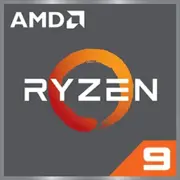AMD Ryzen 9 7940H

AMD Ryzen 9 7940H: Power and Efficiency in a Compact Package
Modern laptops require a balance between performance, energy efficiency, and mobility. The AMD Ryzen 9 7940H (codename Phoenix) is a prime example of such a compromise. It combines 8 cores, an advanced 4nm manufacturing process, and integrated Radeon 780M graphics, promising high speeds for both work tasks and gaming. Let's explore who this chip is suitable for and what advantages it offers.
Architecture and Process: Zen 4 and RDNA 3 Under One Roof
The Heart of the Processor: Cores, Threads, and Cache
The Ryzen 9 7940H is built on the Zen 4 architecture, which replaces Zen 3+. It is AMD's first generation to transition to TSMC's 4nm process, allowing for increased transistor density and reduced power consumption. The configuration includes:
- 8 cores and 16 threads;
- A base frequency of 4.0 GHz and a maximum turbo frequency of 5.2 GHz;
- 16 MB of L3 cache — sufficient for quick data processing in games and professional applications.
Integrated Radeon 780M Graphics
The Radeon 780M graphics core is based on RDNA 3 architecture (the same as in discrete RX 7000 graphics cards). It comprises 12 compute units (768 stream processors) and operates up to 3 GHz. This is the first iGPU to support hybrid ray tracing, paving the way for advanced graphics gaming even without a discrete graphics card.
Power Consumption and TDP: Efficiency First
The processor's TDP (Thermal Design Power) is 35W, categorizing it as a mid-power mobile chip. However, due to the 4nm process, the Ryzen 9 7940H demonstrates impressive energy efficiency:
- In idle or light-load scenarios (web surfing, office tasks), the processor reduces its frequency to 1.5–2 GHz, consuming less than 10W.
- Under maximum load (rendering, gaming), power consumption can reach 45–50W, but the laptop's cooling system must manage such heat output.
Example: In the ASUS ZenBook 14X ultrabook with Ryzen 9 7940H and a 75W·h battery, video playback time reaches 10–12 hours, while active work in Premiere Pro lasts about 3–4 hours.
Performance: Real Tests and Turbo Mode
Office Tasks and Multimedia
- Geekbench 6 Single-Core: 2304 — on par with the desktop Core i5-13600K. The processor responds instantly to actions in browsers, Excel, and Photoshop.
- Geekbench 6 Multi-Core: 11069 — rendering 4K video in DaVinci Resolve takes 15% less time than the previous generation Ryzen 9 6900HX.
Gaming
Thanks to Radeon 780M, the laptop with Ryzen 9 7940H handles gaming at medium settings:
- Cyberpunk 2077 (1080p, FSR Balanced): 45–50 FPS;
- Elden Ring (1080p, medium settings): 55–60 FPS;
- CS2 (1080p, high settings): 120–140 FPS.
Turbo mode automatically boosts CPU frequency to 5.2 GHz, but only with adequate cooling. In thin laptops (like the Lenovo Yoga Slim 7 Pro), the performance boost in games is 8–12%, but temperature can reach 90°C.
Use Cases: Who Is the Ryzen 9 7940H For?
1. Professionals: Video editors, programmers, and designers will appreciate the rendering speed and multi-threading support.
2. Gamers: Suitable for those who want to game without a discrete graphics card (for instance, while traveling) or use an eGPU.
3. General Users: A laptop with this processor can replace both a work desktop and a multimedia center.
Advice: If you frequently work with 3D models or 8K video, it’s better to opt for a model with discrete graphics (like NVIDIA RTX 4070). However, for most tasks, Radeon 780M is sufficient.
Battery Life: How Long Will It Last?
The Ryzen 9 7940H employs several technologies to save energy:
- AMD PowerNow! — dynamically adjusts voltage and frequency.
- Core Parking — disables unused cores.
- SmartShift — redistributes power between CPU and GPU.
Examples of Battery Life:
- Web browsing: 9–11 hours;
- Office tasks (Word, Excel): 7–8 hours;
- Gaming: 1.5–2 hours.
Important: Real battery life depends on the battery capacity. Look for laptops with at least 70W·h.
Comparison with Competitors: Who is Stronger?
1. Intel Core i7-13700H (14 cores, 20 threads):
- Better in single-core tasks (Geekbench 6 Single-Core: ~2500), but consumes up to 60W under load.
- Integrated Intel Xe graphics (96 EU) is 30–40% weaker than Radeon 780M.
2. Apple M2 Pro (12 cores):
- Leader in energy efficiency (up to 18 hours of battery life), but limited compatibility with Windows programs.
- Lacks proper gaming support due to no DirectX support.
3. Previous Generation AMD (Ryzen 9 6900HX):
- The Ryzen 9 7940H is 20–25% faster thanks to Zen 4 and higher frequency.
Pros and Cons of the Ryzen 9 7940H
Strengths:
- High multi-threaded performance.
- Powerful integrated graphics.
- Low power consumption for its class.
- Support for DDR5-5600 and PCIe 4.0.
Weaknesses:
- Potential overheating in compact laptops under load.
- Price: laptops with this processor start from $1200.
- No support for Thunderbolt 4 (only USB4).
Recommendations for Laptop Selection
1. Device Type:
- Ultrabook (e.g., HP Spectre x360): Focus on portability and battery life.
- Gaming Laptop (ASUS TUF A16): Better cooling and eGPU connection capability.
- Workstation (Lenovo ThinkPad P16s): Certified for professional applications.
2. What to Look For:
- Cooling System: At least two fans and heat pipes.
- RAM: 16–32 GB DDR5.
- Storage: 1 TB NVMe SSD.
- Display: For gaming — 120 Hz; for work — 4K or OLED.
Final Conclusion
AMD Ryzen 9 7940H is the ideal choice for anyone seeking a versatile laptop without compromise. It is suitable for:
- Students — powerful enough for study and gaming.
- Freelancers — quick rendering and mobility.
- Gamers — able to play even without discrete graphics.
Key Benefits: Energy efficiency, strong integrated GPU, and readiness for demanding tasks. If you're looking for an "all-in-one" solution, this processor is worth the investment.
Basic
CPU Specifications
Memory Specifications
GPU Specifications
Benchmarks
Compared to Other CPU
Share in social media
Or Link To Us
<a href="https://cputronic.com/cpu/amd-ryzen-9-7940h" target="_blank">AMD Ryzen 9 7940H</a>